Ecommerce Personalization: The Complete Guide for Founders, Merchants, and Marketers
Your ecommerce personalization journey starts here👇
Mastering Ecommerce Customer Retention: Discover strategies to implement retention marketing, reward loyal customers, and more.
Recognize and Reward Repeat Customers: Building customer loyalty is crucial for e-commerce success. Rewarding returning customers with special perks and discounts can encourage repeat purchases and create a sense of appreciation.
Gather Customer Feedback and Encourage Reviews: Incentivize customers to share their opinions through reviews and surveys. This feedback not only helps you improve your products and services but also builds trust and transparency with your customers.
Personalize the Post-Purchase Experience: Personalization can significantly impact customer retention. Offer tailored post-purchase incentives, simplify account access, and provide a seamless online shopping experience to increase customer satisfaction and loyalty.
Your date goes well, and you follow up to ask for a second date. But several days pass and you’re still waiting for a response. You finally accept it: You’ve been ghosted.

Ecommerce brands experience this heartbreak all the time. But, like dating, you can learn from these experiences.
Every time a customer ghosts you, it’s an opportunity to improve your business and implement strategies that help you build a solid foundation of loyal customers. With the right ecommerce customer retention strategies in place, you can woo your one-time buyers into a lifelong relationship with your brand!
Recognizing your repeat customers benefits both your business and the customers. For your business, existing customers are more likely to try new products and spend more than new customers. For the customer, recognition can make them feel appreciated.
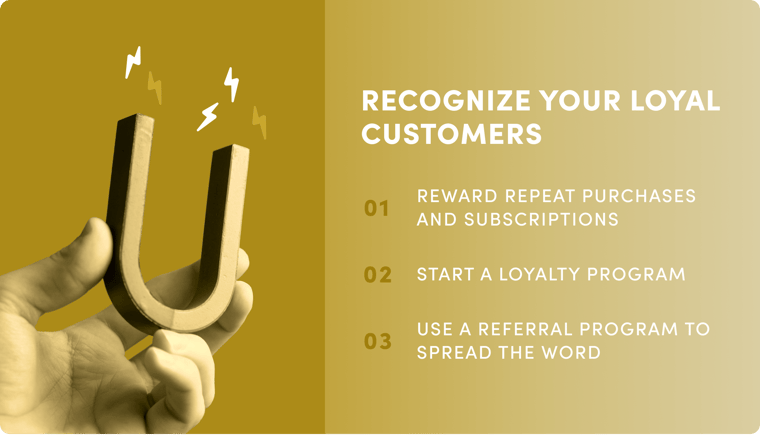
Rewarding returning customers who make repeat purchases or sign up for subscriptions with special perks and discounts shows you value their business. To start, make sure you’re tracking purchase frequency as a key metric in your analytics. This way, you can easily segment customers into groups based on purchasing behavior.
For example, you might decide that after three repeat purchases, the next time they’re in their shopping cart, you’ll offer them a special gift or discount. You can do this by using a modern shopping cart to keep track of their purchases and set up an automatic notification of their discounted price.
Alternatively, if you have a subscription option, you can recommend that they subscribe to save money. Make this appealing by showing them how much money they’ll be saving. It’s also good practice to offer a “skip this month’s subscription” option in their account settings so they don’t feel like they have to commit to a certain number of purchases.
See how vitamin brand OLLY increased subscription revenue by 63%.
A customer loyalty program is another great way to recognize your dedicated customers, reward them for spending money, and increase revenue for your business. Customers love a good loyalty program. In fact, 74% of them are more likely to recommend a company that has a top-notch loyalty program.
To increase customer lifetime value through a loyalty program, you can:
Pro tip: Consider offering unique rewards that follow current tech trends, like cryptocurrency rewards.
Referral programs incentivize your customers to share their love for your brand and products with their friends and family. These programs make the most of word-of-mouth recommendations, as 82% of Americans seek recommendations before purchasing a product.
Here’s how to set up a referral rewards program:
For example, you might decide that for every 10 referrals a customer makes, that customer gets a discount on their next order. And for every referral that turns into a new sale, that customer gets an additional reward.
Another way to make your customers feel valued is to ask for their opinions on your products. This provides customers with an outlet to express how they feel, whether positive, negative, confused, or ambivalent. It also presents your business with an opportunity to learn from them and use their thoughts to make decisions about your business.
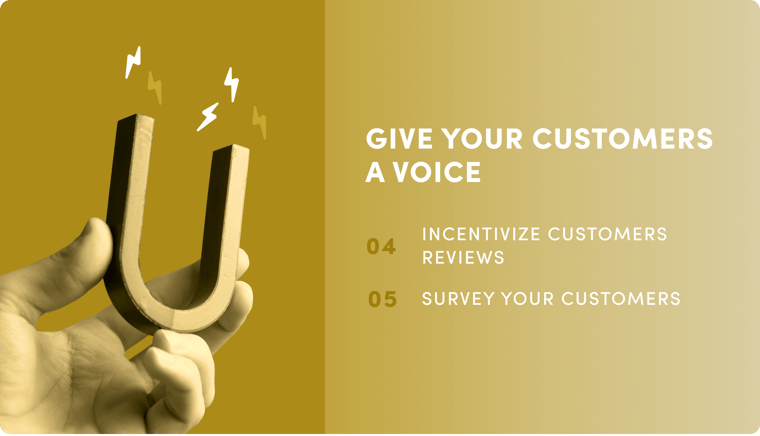
Incentives can motivate customers who are on the fence about sharing a review to go ahead and click that publish button. Asking for reviews shows your customers you care about their opinions and about maintaining transparency about your brand. When you give customers the option to share their opinions about your products, you can increase trust between you, your existing customers, and any new ones who visit your site.
According to the Local Consumer Review Survey, 98% of people read reviews, which shows how important reviews are to customers. Don't worry if not every review is a glowing five-star rating. Having a mix of positive and negative reviews makes your store seem more legitimate and provides valuable social proof for your business.
There are a number of ways you can encourage customers to leave reviews. In exchange for a review, you can:
Pro tip: Reply to existing reviews so that customers see you are engaged and care about the reviews they write. It’s especially crucial to follow up on negative reviews and show the actions that have been taken to address an issue.
Sending out a survey or asking for direct feedback from your customers is another way to listen to their opinions and requests. It shows current customers that you care about what they want and how they feel about your brand and products. Since 73% of customers expect companies to understand their unique needs, getting feedback is important to make sure you’re addressing those needs so that you can retain those customers.
The data you glean from these surveys can improve your business and help you capitalize on what’s working and bringing customers satisfaction. For example, do you need to make any product improvements or improve customer service skills?
Here are a few tips on how to request feedback:
Once you’ve successfully received their assessments, it’s crucial to reply to them — especially if they’ve shared concerns or critical feedback. Not only is it the decent thing to do for a customer who took the time to respond, but customers also feel more loyal to brands that respond to feedback. In your response, only make promises you can keep, like promising to resolve the issue or share their feedback with the design and development team.
A seamless customer experience in your ecommerce store can improve the customer’s perception of your brand and products. First-time customers shouldn’t have to white-knuckle their way through your online store design. Navigation should be easy, intuitive, and user-friendly. Whenever possible, offer support and be transparent with your customers about things like returns, shipping speed, or other customer concerns.
Providing multiple opportunities for customers to get in touch with your support team can help increase customer satisfaction and, as a result, customer retention rate. Here are a few steps for offering effective customer support:
In order for any of these methods to be effective, it’s important that your support team is well-trained on how to properly build customer relationships. From active listening, prompt responses, and showing empathy and patience to efficient problem-solving, your customer service team has the power to positively affect customer retention. You should also provide your support team with data and analytics on customer behavior so they can offer personalized assistance.
Making it easy for customers to access their account on your ecommerce site can improve the user experience as it reduces support requests or frustration on the customer’s side. When they don’t have trouble signing into their account, they can, for instance, easily view what they purchased last time in order to re-purchase it, send a return, or find a related product.
Here are a few best practices for simplifying account access:
Pro tip: Create quick access links to specific pages in their account. For example, if they’re looking for past orders, you can display or link to reorder landing pages.
Above: Rebuy Reorder Landing Page for Gamer Supps.
A personalized post-purchase experience can increase sales, boost customer loyalty, and, as a result, improve retention. According to a Segment report, 62% of companies cite personalization as a reason for an increase in customer retention.
Here are a few ways you can use personalization post-purchase to increase customer retention, with the bonus of increasing your average order value (AOV):
Pro tip: You can use Rebuy Smart Cart to personalize the cart and checkout experience for you!
Customers shouldn’t have to reach out to support to find out why they still haven’t received their products or how to process a return. If you don’t make shipping and return processes easy, your customers aren’t going to stick around.
According to a report by Shippo, free shipping is their biggest shopping concern. When it comes to returns, Happy Returns found that “50% of shoppers have abandoned a purchase because the merchant did not offer a convenient return method, like box-free returns.”
You should have a clear and transparent delivery, return, and refund process that’s easy to find from the second a customer decides to purchase your items until they receive them.
Here are ways to be transparent and make it easy for customers to manage delivery, returns, and refunds:
Pro tip: Get feedback about how the delivery went or why they decided to return so you can improve your system.
Strategically revising and improving your marketing efforts can also help you increase customer retention. Start by using customer data to target specific segments. Then, focus on relevant channels like mobile commerce and live commerce. And finally, leverage automation whenever possible so you can effectively reach your customers.
Email marketing allows you to deliver personalized messages that resonate with your customers’ needs by providing the right value at the right time. By doing so, you can improve the likelihood of customer retention and increased sales. For example, if you work in retail, the average ROI for email marketing is 45%.
Here’s how to design effective email marketing retention campaigns:
Pro tip: Implement A/B testing by experimenting with different subject lines, visuals, or copy to determine which is most effective.

Rebuy integrates with Klaviyo to add personalized product recommendations to your email campaigns.
SMS marketing reaches consumers directly where they already spend a lot of time: on their mobile devices. The latest research from SimpleTexting indicates that the SMS open rate is at 98% and the conversion rate is at 29%.
As with email marketing, SMS marketing messages should be personalized and use clear and convincing CTAs. However, here are a few tips for leveraging SMS marketing that diverges from email and other forms of communication:
.png?width=2568&height=1940&name=attentive%20example%20(comp).png)
Rebuy Smart Cart integrates with Attentive to power your SMS program.
Pro tip: Create a contact card for your business so recipients can easily add your number to their contacts. Make it fun and add a photo or logo to maintain consistent branding.
You can keep your brand top of mind by engaging with customers on social media and dipping your toes into the increasingly popular social commerce landscape. Next year, social commerce is expected to reach $1.7 billion in projected sales. According to Mintel, about half of U.S. consumers have bought a product on social media. With the right kind of customer engagement and social commerce strategy, you can also improve your likeability and increase overall brand loyalty.
Here are some ways to engage with your customers on social media:
Pro tip: Start learning more about the metaverse and how your business can interact with customers there. According to Shopify's ecommerce trends report, many believe that shopping in the metaverse will soon become more commonplace.
Your ecommerce personalization journey starts here👇
In a nutshell, customer retention is about basing the majority of your decisions and strategies on the customer. It’s important to preface your decisions by examining their needs, values, and stories. If your business is doing well, that could actually be a lot of customers to keep up with. And not all of them have the same needs, values, or stories.
This brings us to a bonus strategy: Use AI tools to do all of the merchandising for you.
A commerce AI company like Rebuy can help you create engaging, individualized, and intelligent shopping experiences. When you integrate Rebuy with your online store, you’ll be adding an AI employee that can help you implement your customer retention strategies.
•••
Try Rebuy free and see why the world’s top brands use Rebuy to accelerate sales growth.
Interested in partnering with Rebuy? Let's do it.
To keep up with the latest trends, platform updates, and more, follow us on LinkedIn.
Explore the world of customer retention. Learn practical tactics to improve customer retention, re-engage customers, and measure your efforts.
Emails play an integral role in your retention strategy. Try these 6 popular customer retention emails to keep customers and boost retention rates.
Emails play an integral role in your retention strategy. Try these 6 popular customer retention emails to keep customers and boost retention rates.
Stay up to date with all things Rebuy by signing up for our newsletter.
